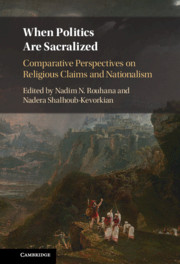Book contents
- When Politics Are Sacralized
- When Politics Are Sacralized
- Copyright page
- Contents
- Figures
- Maps
- Tables
- Contributors
- Preface and Acknowledgments
- 1 A Comparative Perspective on Religious Claims and Sacralized Politics
- Part I Israel
- 2 Religion and Nationalism in the Jewish and Zionist Context
- 3 Religious Claims and Nationalism in Zionism
- 4 On the Uses and Abuses of Tradition
- 5 The Relations between the Nationalization of Israel’s Politics and the Religionization of Its Military, 1948–2016
- 6 Sacralized Politics
- Part II India
- Part III Sri Lanka
- Part IV Serbia
- Part V Iran
- Part VI Saudi Arabia and Wahhabism
- Part VII Northern Ireland
- Part VIII Palestine
- Index
- References
5 - The Relations between the Nationalization of Israel’s Politics and the Religionization of Its Military, 1948–2016
from Part I - Israel
Published online by Cambridge University Press: 10 June 2021
- When Politics Are Sacralized
- When Politics Are Sacralized
- Copyright page
- Contents
- Figures
- Maps
- Tables
- Contributors
- Preface and Acknowledgments
- 1 A Comparative Perspective on Religious Claims and Sacralized Politics
- Part I Israel
- 2 Religion and Nationalism in the Jewish and Zionist Context
- 3 Religious Claims and Nationalism in Zionism
- 4 On the Uses and Abuses of Tradition
- 5 The Relations between the Nationalization of Israel’s Politics and the Religionization of Its Military, 1948–2016
- 6 Sacralized Politics
- Part II India
- Part III Sri Lanka
- Part IV Serbia
- Part V Iran
- Part VI Saudi Arabia and Wahhabism
- Part VII Northern Ireland
- Part VIII Palestine
- Index
- References
Summary
This chapter engages with the neglected correlation between the religionization of the Israeli military and the religionization of politics. It is argued that we can identify four main stages of the relationship between the religionization of military and politics. During the formative period of the state and the military (1950s–60s), the partial religionization of the military reflected similar processes in the general society. In the second stage, following the 1967 War, the responses to the war’s aftermath strengthened ethno-national religionization. However, ethno-national religionization prompted the proponents of this process – the national-religious sector – to develop an extra-military avenue for upward mobility in the form of the settlement enterprise in the Occupied Territories. The third stage (1980s–90s) was characterized by the denationalization of Israeli politics with the Oslo Accords at its center, during which the national-religious sector increased its strongholds in the military by leveraging new opportunities created by the partial retreat of secular groups from the military as an avenue of upward social mobility. The fruits of this move were felt in the fourth stage (2000s), when the religionization of the military occurred in tandem with, and was bolstered by, the religionization of politics.
Keywords
- Type
- Chapter
- Information
- When Politics are SacralizedComparative Perspectives on Religious Claims and Nationalism, pp. 113 - 133Publisher: Cambridge University PressPrint publication year: 2021

